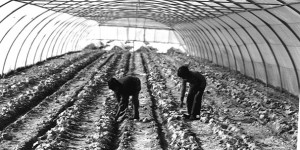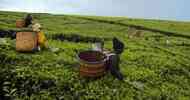Dubai
Africa's untapped agriculture potential make it an ideal partner for resource-constrained Middle Eastern countries that seek to improve their food security, a new report from Standard Chartered Bank said.
The African continent is relatively land-abundant, land utilisation rates are low, and – contrary to widespread perception – has plenty of water.
Given its potential, Africa therefore appears to be a natural destination for agricultural investment by Middle Eastern countries, but there are valid concerns about whether it can play a significant role in addressing the Middle East’s food security issues, the report said.
Africa’s agricultural potential has not been realised so far. It has abundant arable land and water relative to Asia and the Middle East. According to the Food and Agriculture Organisation (FAO), Africa’s per-capita water resource averages 4,600m3, compared with just 164m3 in the Middle East.
Not only are Africa’s agricultural resources considerable, but they are underutilised too. The FAO estimates that less than 15 per cent of Africa’s total arable land is under cultivation.
The ‘green revolution’ in the 1960s, which sowed the seeds of the astonishing economic progress made by many countries in Asia, has not yet occurred in Africa, for a number of reasons.
Africa continues to depend on rain-fed agriculture, and there is low use of fertilisers, low investment in research and development, and poor infrastructure. Key constraints to investment, in turn, have been a generally poor investment climate and complex tenure arrangements.
The FAO estimates that 90 per cent of land in Africa is not covered by formal legal frameworks. This is a daunting prospect for potential investors, and also reduces investment incentives for those currently utilising the land.
As a consequence, despite its potential, Africa is not self-sufficient in terms of food. In addition, yields from cultivated land tend to be low compared with other regions.
Since the food crisis in 2007 and 2008, there has been a growing emphasis on this sector – which has been neglected by domestic policy makers and donors for decades – and food security is now firmly back on many countries’ policy agendas. Developing agriculture is important to establish food security and reduce poverty.
Agriculture remains of central importance to African countries’ economic prospects, and in addition, most Africans still work on farms (on average, agriculture represents 34 per cent of GDP and 64 per cent of employment, according to the World Bank.
Geographical considerations also make Africa attractive as a source of food imports for the Middle East. It is no surprise that East African countries rank among the top African exporters to the Middle East, given their huge agricultural potential and geographical proximity.
South Africa is Africa’s top exporter to the Middle East as it is one of the few countries in Africa that has traditionally operated a relatively advanced commercial farming model. Moreover, South Africa does not face many of the challenges – including weak agricultural investment – that less developed African countries do.
Overall, Africa currently plays a minor role in providing food to the Middle East. According to data from Comtrade, food imports from Africa represent only a fraction of total food imports to the Middle East (1.2 per cent for the UAE in 2008 and 1.4 per cent for Saudi Arabia in 2007).
The Middle East still relies on large advanced agricultural countries for its food imports. The importance of Africa as a food supplier has probably increased recently, but more up-to-date data is not yet available. Given the low base and the recent agricultural investments, Middle East food imports from Africa are set to rise in the near term.
While the challenges are clear, there is no consensus on the best development model for agriculture in Africa and recently, debate over the role of foreign investors has been growing. Comprehensive statistics on agricultural land deals involving foreign investors in Africa do not yet exist, but what is certain is that Africa is a key locus of this global trend, and that the scale of transactions is already material.
Since 2006, deals have been concluded in at least 12 African ‘host’ countries, with sovereign or private-sector counterparties in 14 investor countries. The total farmland involved in just the limited number of deals for which data is available amounts to 8.66mn hectares (ha), according to the International Food Policy Research Institute (IFPRI) – about the same size as Italy’s arable land endowment.
Since Africa is itself food insecure, the crucial question is its ability to address the issue of food security in other regions. It is also debatable whether land acquisition by foreign investors can lead to a win-win situation for the host and the acquirer.
The outlook for the Mena region from an agricultural perspective is dominated by two factors: water and demographics. Mena is one of the world’s most import-dependent regions in terms of food. This is because of a shortage of water resources, which makes it difficult to grow water-intensive crops such as grains, as well as high demand from a young and growing population.
According to Aquastat statistics, only Algeria, Iran and Oman can meet their water needs with their current resources. There are extreme cases, such as the UAE and Saudi Arabia, where annual water use is up to 10 times higher than available resources. Almost every country in the Middle East is expected to experience water scarcity by 2025.
Within the Mena region, the population of GCC countries is expected to double from 30 million in 2000 to around 60 million by 2030. Another extreme example within the Mena region is Yemen, whose population has risen from about four million in 1950 to about 24 million currently and is forecast by the UN to grow to as high as 60 million in 2050.
This twin problem of a young and growing population coupled with dwindling water resources suggests that countries in the Mena region need to be more proactive in their policies regarding food self-sufficiency.
Until recently, the region was able to finance its food imports with relative ease on account of healthy hydrocarbon receipts and, in the case of Saudi Arabia, an ambitious programme aimed at wheat self sufficiency, which significantly reduced its food import bill.
The food crisis that erupted in the 2007/08 season was triggered by poor global harvests, high energy prices, investor demand and an acceleration in demand for grains from the biofuel sector. It led to a significant drop in the stock-to-use ratios for major grains. The impact of the crisis was felt most acutely by vulnerable food-deficit countries, but it also affected high-income food-deficit countries, including many in the Middle East.
A number of key food-exporting countries, including Egypt and India, restricted their exports, significantly undermining the Mena region’s ability to secure ample food stocks. Of particular importance for the Middle East was India’s ban on non-basmati rice exports. As the largest importer of rice from India, the consequences of the ban were tangible for countries like Saudi Arabia and the UAE, fuelling inflationary pressure.
Policy makers in the Mena region have generally employed a 3C (cap, conserve and contract) approach to dealing with the threat of rising food inflation.
Cap: In the UAE, the government opted to impose price caps on agricultural products at 2007 levels, on the basis that higher local prices would disproportionately affect lower-income groups. 'Our view is that such policies only work as short-term stop-gap measures,' the report said.
Conserve: Mena governments are also looking at ways to conserve water resources and, in the UAE in particular, the government is aiming to pass its first federal water conservation law that addresses water resources policy implementation and conservation issues. This is even more pressing, given that fresh water flowing into the Arabian gulf has fallen by around 70 per cent from 1980s levels. Mena governments are also seeking to build more dams and to improve water retention and refill water tables and aquifers.
Contract: The acquisition of and foreign direct investment (FDI) in arable land has gained impetus as capital-rich, net food importers such as the GCC economies change the profile of such investments. They regard them not as financial investments per se, but as investments aimed primarily at improving food security through ‘controlling’ overseas land supply which dedicates its food output to their region.
A major impediment to increasing food supply in the Mena region is the tight availability of land. We calculate that the total harvested area for corn, soybeans, rice and wheat has remained largely flat, at around 28mn ha, since the 1990/91 season, the report said.
Arable land in the Mena region grew by less than 6 per cent between 1961 and 2007, below the global average of 10 per cent during this period and well below the 45 per cent increase recorded in Africa. It is against this backdrop that public and private investors from the Mena region have been at the forefront of overseas land and farm purchases.
Mena investment in foreign agriculture is not a new phenomenon and there are examples of minor projects implemented in the 1980s and 1990s under plans to develop Sudan as a bread basket for the Gulf region. While there was also some interest in 2000, the bulk of international land deals were reported in 2008, coinciding with the food crisis.
Typically, Mena countries have tended to focus their agricultural FDI/land acquisition on seven countries – Sudan, Mozambique, Ethiopia, Tanzania, Kenya, Mali and Senegal. This is in line with the key drivers we discussed earlier, including the availability of agricultural land, geographical proximity and international relations, the report said.
Despite the vast agricultural potential that exists in Africa compared with the Middle East, most of the target countries (and, indeed, almost all countries in Africa) are currently net grain importers, with very volatile grain output due in part to difficult climatic conditions and a scarcity of rain. This is the case in Senegal; and while Mozambique is relatively better endowed, with considerable reserves of arable land and water resources for irrigation that could be used for agricultural production, it is still a net food importer.
Overall, Africa’s export potential is limited and, according to the Gulf Research Council, it may not be able to overcome the constraints of climate, water and land, even after intense investment activity. We believe this statement to be a worst-case scenario which does not apply to numerous countries in Africa; we see significant upside for agriculture from increased investment, the report said.
In particular, we believe investment targeted at utilising Africa’s renewable fresh-water resources for irrigation is key to improving agricultural prospects. Mozambique is one country with strong potential for irrigation, given that irrigated crops only make up around 3 per cent of agricultural production. Moreover, in 2002, its cultivated area was estimated by the FAO at 4.44mn ha, of which 4.20mn ha was arable land and 0.24mn ha was under permanent crops. This compares with estimated total cultivable land of 36mn ha.
More recently, the combination of the global economic recession and improved supply conditions has helped to reduce prices and consequently dampened the frenzied activity in agricultural land agreements. However, the underlying pressure to expand output to meet growing demand over the longer term has not disappeared.
Theoretically, it is possible for the Mena region to become self-sufficient in wheat by 2030, assuming that per-capita consumption remains flat and output continues to grow at 3 per cent per annum (the average annual growth rate since 2001). However, meeting this target would require slower population growth, much more efficient water use, significant yield enhancement (crop per drop), and a higher share of the region’s precious water resources dedicated to food production.
Allocating all the water required for sufficient grain production would be detrimental to total GDP if water was diverted from other, more economically productive uses. To meet agriculture’s needs and to maintain living standards and industrial growth would require a huge commitment to desalination to provide enough water. Until concentrated solar thermal desalination is made commercially viable, such desalination will rely on the use of fossil fuels, with the ensuing cost and increase in greenhouse gas emissions.
Crops grown in hot, dry conditions require more water, even if water management issues are addressed and efforts are made to irrigate farmland more efficiently. This needs to be weighed against the option of importing virtual water via grain imports. Against this backdrop, a win-win model can be envisaged as, in principle, the growing trend of foreign investment in agricultural land in Africa could spur progress in the form of investment in agri-supportive infrastructure. Transfers of skills and technology, as well as increased local employment, are realistic prospects.
However, uncertainties and political sensitivities abound. Land, more than simply being a tradable commodity, is integral to the identity of local communities. It may be bound up in national sovereignty and pride, and it remains fundamental to the livelihoods of the majority of people in most African countries.
The prospect of potentially food-insecure countries ceding food production resources to outside interests is also an uncomfortable one. The establishment of best practices – facilitated by guidelines which are now in the process of being drawn up by international institutions – will be helpful. Transparency, sustainability, and a meaningful return for local communities will be fundamental elements.
Countries such as Mozambique and Sudan are potentially viable destinations for agricultural FDI by Middle Eastern countries, as are other African countries with the same endowments, particularly when combined with attractive investment environments. However, the infrastructure development required is considerable, and we share the view that such projects would need to be accompanied by a comprehensive development strategy, the report concluded.-TradeArabia News Service













